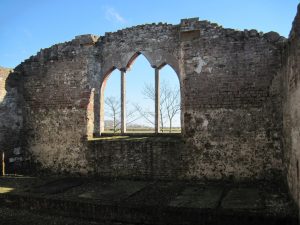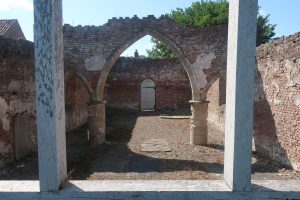
From ancient times until the mid 19th century Nunkeeling was considered an important ecclesiastical parish owing to its priory. Situated in what was once the wapentake of Holderness, North division, part of the historical East Riding of Yorkshire (see maps in Introduction), it included the sub-parishes and localities of Bewholme and Billings Hill. However, at the time of the 1832 parish boundary changes it was absorbed into the enlarged civil parish of Bewholme. Its original name Chilinghe or Killing is Anglian, meaning the place of Cylla and his people. In the 17th century it was called Little Keeling, and it was only later that Nun replaced the former prefix. Neither Killing, Little Keeling nor Nunkeeling ever referred to recognised settlements, rather to the area over which dwellings were scattered and where a priory for nuns of the Benedictine order was built.

© Milestone Society, 2018
Before the Conquest the manor of Chilinghe was in the hands of two Angles, both called Chilvert or Ketilfrith; Ulf the Fenman also had lands there as part of his Beeford possessions. By 1086 Baldwin of Flanders was the lord of the first manor under Drogo de la Beuvrière, the tenant in chief of all the Nunkeeling lands, forming part of his vast single holding of Holderness. Soon afterwards he whole of Drogo’s possessions were confiscated and awarded to Odo de Champagne, William I’s brother-in-law, whose descendants took the title Aumale. In the early 12th century Herbert de St. Quintin was a tenant of Stephen, Count of Aumale, and it was the former’s widow Agnes de Arches who founded Nunkeeling priory in c1150 in honour of St. Mary Magdalene and St. Helen for the health of the souls of her late husband and two of her sons. (Agnes was also the widow of a de Fauconberg, whose manor of Catfoss she held in dower, hence her alternative name Agnes de Catfoss.)

Agnes endowed the priory with land for the maintenance of twelve nuns, and gave to it the parish church. However, in 1316 the prioress was named sole lord of Nunkeeling, and in 1409 the priory appropriated the church. By 1540 when the priory and its site were surrendered to the Crown during the Dissolution, Agnes’s endowment had been considerably enlarged by grants of many places in Holderness. The Crown granted the lands at Nunkeeling and Bewholme to Sir Richard Gresham, but the priory church was neglected and gradually fell into decline, the props shown on a copy of an engraving dated 1784 attesting to its ruinous state. In the late 17th or early 18th century it was almost totally demolished and a manor house was built on its site, incorporating only a buttress and some stonework from the former building. The manor house served as the farm house for Church farm until 1967, when it was sold off. It has since been remodelled and renamed Nunkeeling Priory. The only other feature of note within the area of the priory buildings is Magdalen Cottage, situated beside the road leading to Catfoss. Against the wall of the cottage and standing about four feet high is the broken shaft of an ancient cross. It is octagonal and appears to have once borne some ornamentation.
The parish church, standing to the east of the priory church, was dedicated to St. Mary Magdalene and St. Helena at the foundation of the priory. It was originally a very simple structure, comprising a chancel and a nave. A north aisle was added in the 13th century, when the chancel was also remodelled. It too gradually fell into disrepair, and by the end of the 18th century the chancel was roofless. In 1810 the church was rebuilt of boulders and brick with stone dressings and was given a western turret for its single bell. Materials from the original structure, like the circular pillars, were used in the rebuild. However, like its predecessor, the rebuilt parish church fell into disrepair and ceased to be used by 1928. In 1987, rather than demolish it, the walls of the unroofed building were consolidated and stabilised by the parish council. In the meantime a number of the church’s ancient features had been rescued: in 1939 the circular Norman font, resting on four piers, was removed to St. Martin’s church, Hull; in 1948 Hornsea church received the mutilated stone effigy of Sir Andrew de Fauconberg in 14th century armour and that of his lady; and the church bell, rehung in 1908, was later removed to Bewholme.
 |  © Paul Harrop, 2008 |  © Martin Dawes, 2013 |  |

Bewholme has a Scandanavian name which is believed to refer to bends in a river, presumably Stream Dike which forms the eastern parish boundary. There was a manor house here which lay on the road to Catfoss. Its current incarnation, a two storey brick house with a striking porch that seems too big for it, was built in the early 18th century and enlarged and remodelled in the mid 19th century.
In 1066 the manor of Bewholme was held by Norman, Ketilfrith and Thorkil. As in Nunkeeling, by 1086 it had passed into the hands of Drogo de la Beuvrière, with Manbodo as its lord, and later formed part of the Aumale family’s possessions. Agnes de Arches gave the land and rights of Bewholme Wood to Nunkeeling Priory at its founding in c1150. In the mid 1200s the priory held half of Bewholme, and by 1276 it had a total of five carucates at Nunkeeling and Bewholme. It was the Fauconbergs who held the other part of Bewholme. In 1202 Parnel, widow of Stephen de Fauconberg, released to Stephen’s brother Walter and his wife Agnes, her sister, land of the Fauconbergs at Bewholme which she presumably held in dower. Walter and Agnes were succeeded by William de Fauconberg, who held half of Bewholme in the mid 13th century. In 1278 William’s successor Walter, son of John, shared the estate at Bewholme with Herbert de St. Quintin (one of many to bear the name Herbert). Walter was created Lord Fauconberg of Bewholme in 1316. Another John de Fauconberg, who was holding land at Bewholme of Lady Isabel de Fauconberg’s manor of Rise, was succeeded at his death in 1366 by his son Sir Walter. This estate probably descended with Walter’s other land in Bewholme, and it seems to have been the same which Hilary Constable held at his death in 1571. The Fauconberg estate at Bewholme descended as an appurtenance of the family’s manor of Rise to their successors, the Nevilles, and later to the Crown.

As the parish church stood two kilometres west of Bewholme, in the mid 1850s a closer place of worship was deemed necessary. Bewholme school had been licensed for services in 1857, though Sunday service was still being held at the parish church, albeit only in summer. By 1865 weekly services were being held at the school throughout the year. A parsonage was built in 1859, a year before a church for Bewholme was designed but not built. In c1875 the vicarage coach house was converted to serve as a chapel-of-ease, and in 1895 adjacent land was consecrated as a burial ground. It was also on this land that a church for the people of Bewholme was finally built. It was a mission church, dedicated in 1900 to St. John the Baptist, and licensed for all services except marriage. In 1928 services were discontinued at Nunkeeling and the mission church became the parish church, receiving a licence for marriages in 1929.
Billings Hill is one of the highest parts of Holderness with commanding views over the Wolds. Billings Hill farm stands atop the hill; its farmhouse was built in the late 18th century.
Robert Puckering, a farmer of the 9th generation of the Puckerings of Flamborough moved with his wife and their first two children to Nunkeeling in 1777; their other nine children were born there, but by the 12th generation there were no Puckerings left in the parish.
Francis Pickering of the 24th generation of Pickerings of Wawne also moved with his wife and their first two children to the parish, settling in Bewholme where he was a machine wright. His first surviving son Emmanuel carried on the trade and became a master machinist, but his youngest son John, a baker, emigrated to Australia with his wife and six children and settled in Yarrinbool, New South Wales.
Sources:
https://www.genuki.org.uk/big/eng/YKS/ERY/Nunkeeling
https://intel-hub.eastriding.gov.uk/parish-profile/#/view-report/bd6a0cb7f85a46998f874a42bfd0dc8e/PP015
https://en.wikipedia.org/wiki/Nunkeeling
https://en.wikipedia.org/wiki/Bewholme
https://en.wikipedia.org/wiki/Nunkeeling_Priory
https://opendomesday.org/place/TA1450/nunkeeling
https://opendomesday.org/place/TA1650/bewholme
Transactions of the East Riding Antiquarian Society: The de St. Quintins, vol. 10, pp. 20-21:
https://archive.org/details/transactions26socigoog/page/n48
Victoria History of the County of York, East Riding, vol. 7, pp. 321-329: https://www.british-history.ac.uk/vch/yorks/east/vol7/pp321-329
Bulmer’s History, Topography and Directory of East Yorkshire with Hull 1892, pp. 461-462: https://specialcollections.le.ac.uk/digital/collection/p16445coll4/id/324025
History and Topography of Yorkshire, vol. 2, York, Ainsty, East Riding, pp. 425-427: https://books.google.fr/books?redir_esc=y&id=unEKAQAAMAAJ
The Buildings of England, York and the East Riding, pp. 639: https://archive.org/details/yorkshireyorkeas0000pevs/page/639
Priory of Nunkeeling: https://www.british-history.ac.uk/vch/yorks/vol3/pp119-122
Church of Saint Mary Magdalene and Saint Helena: https://historicengland.org.uk/listing/the-list/list-entry/1249440
